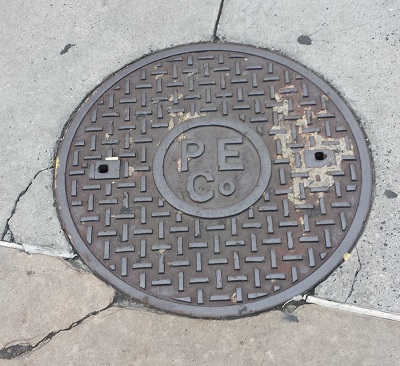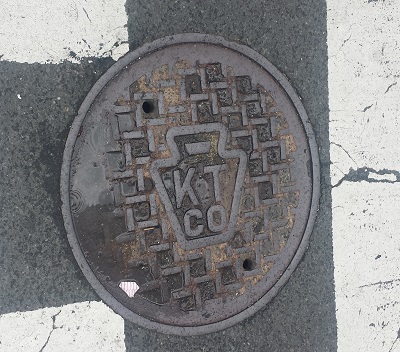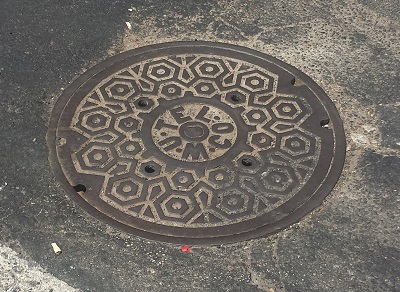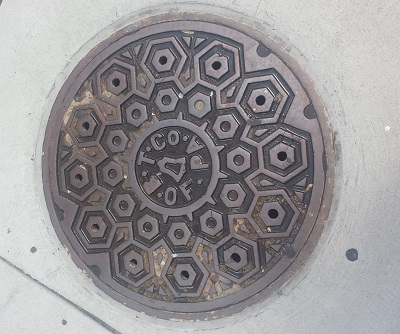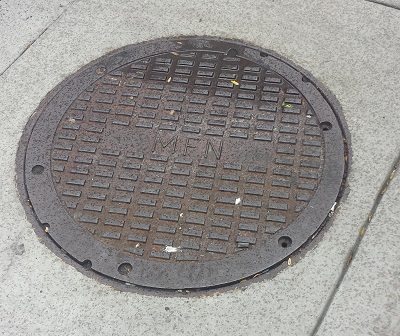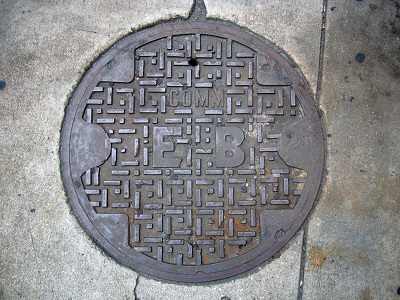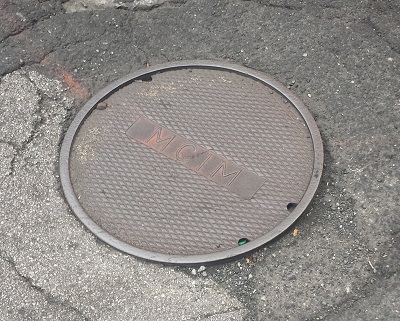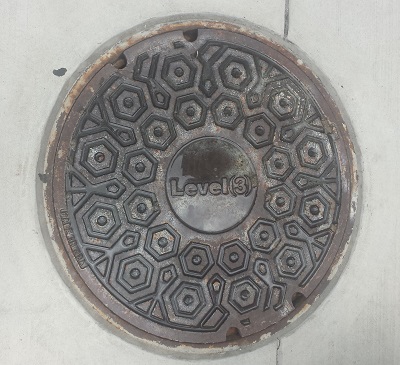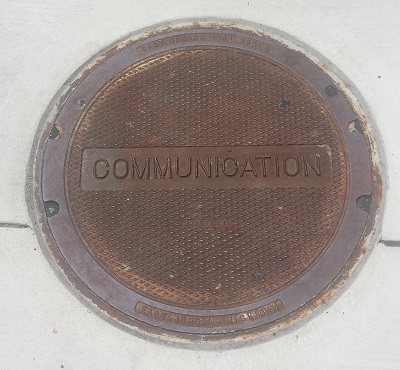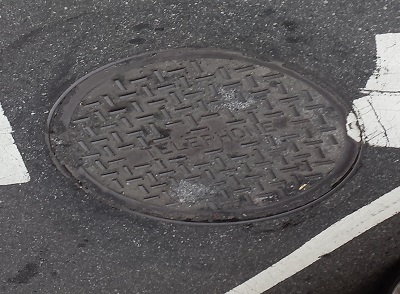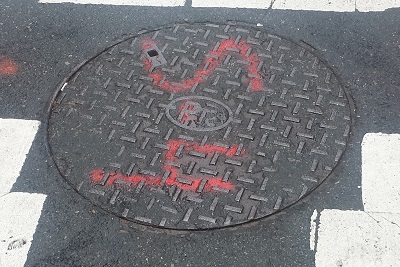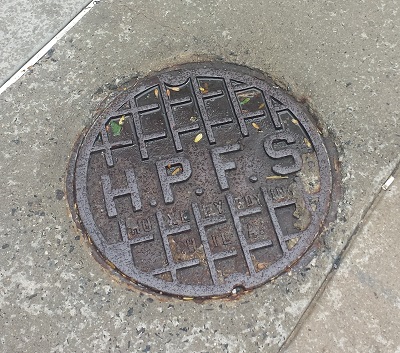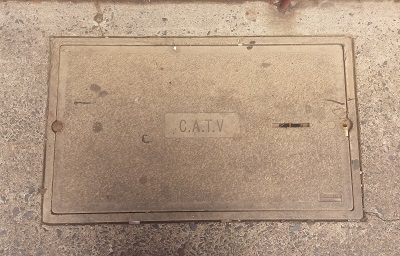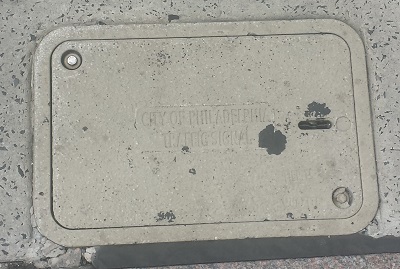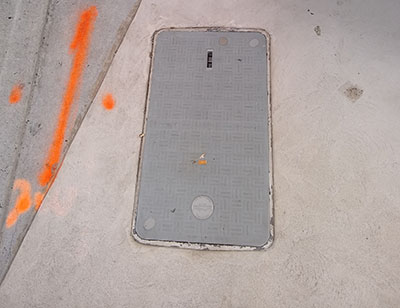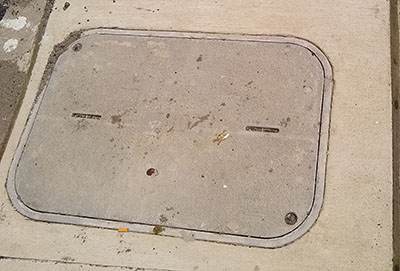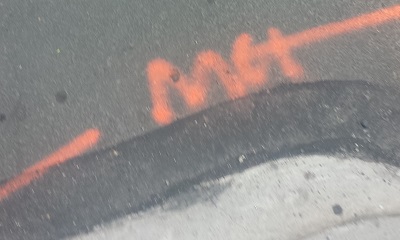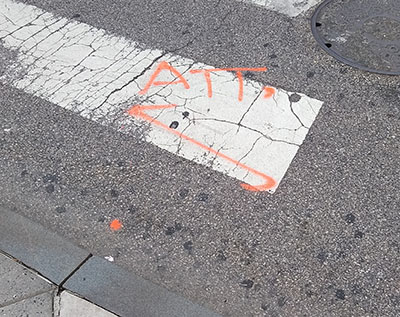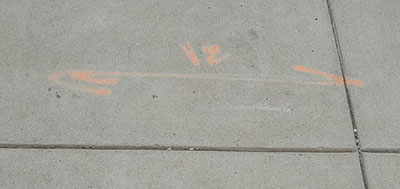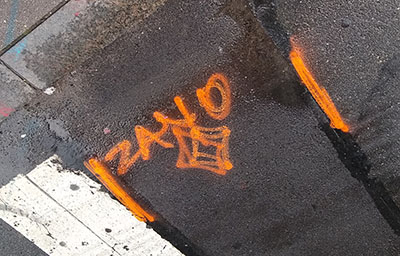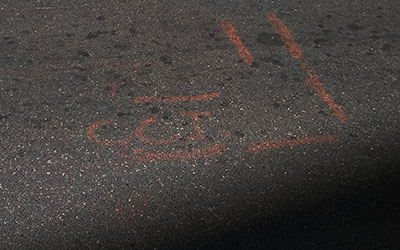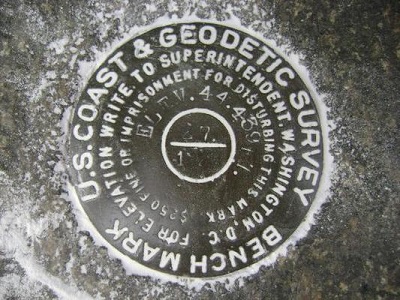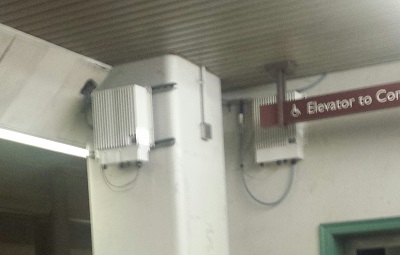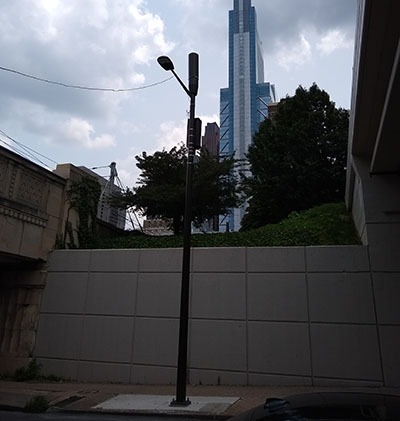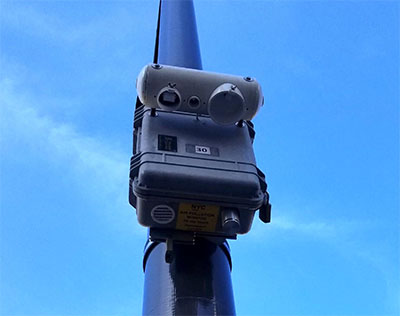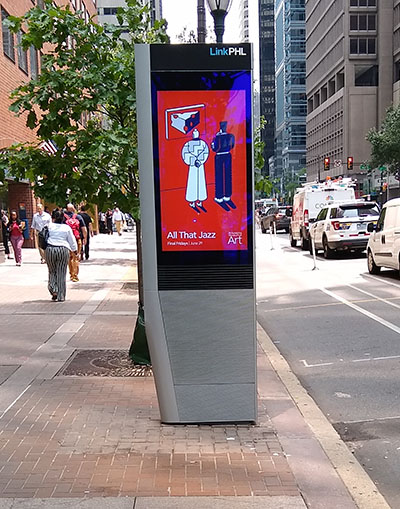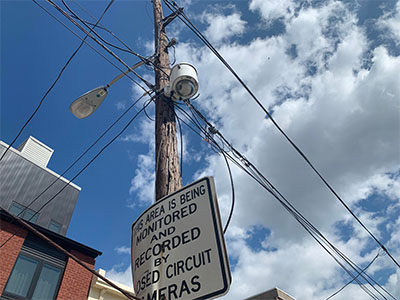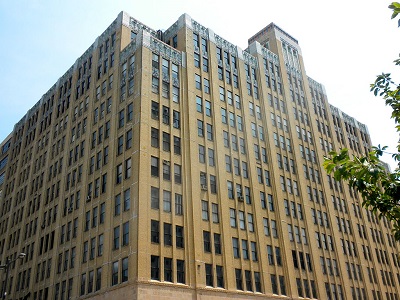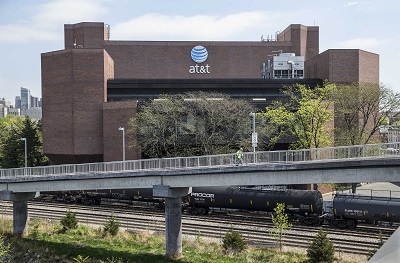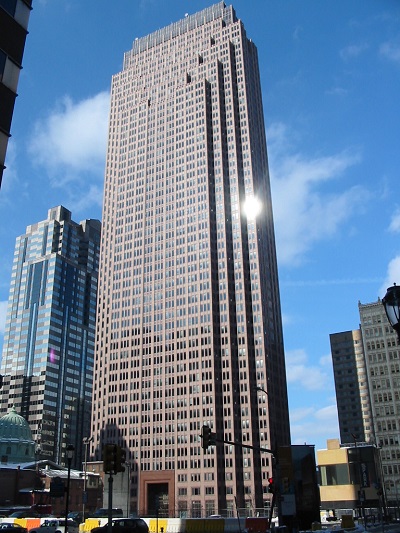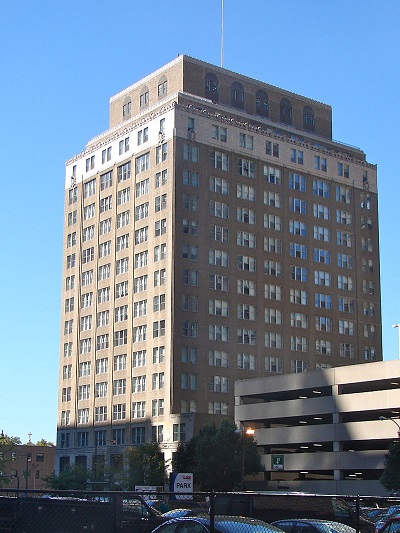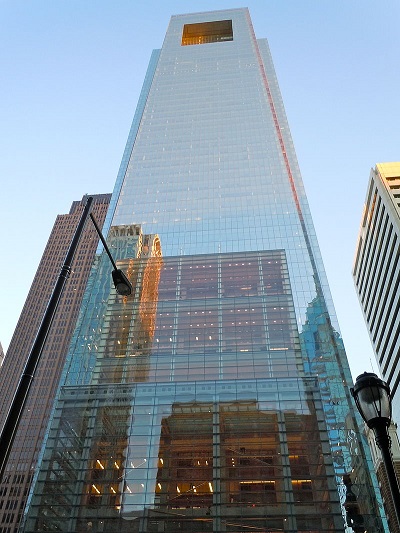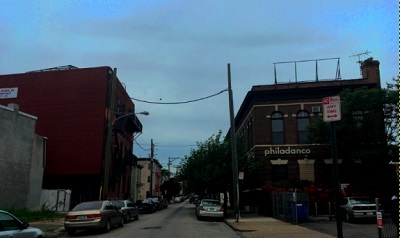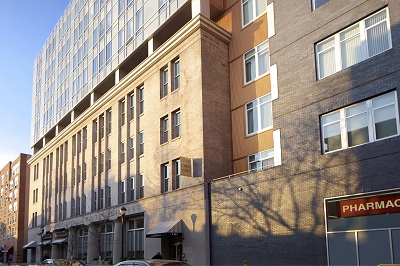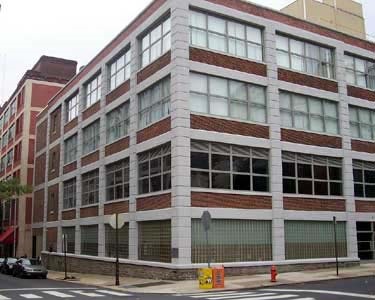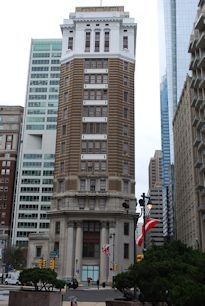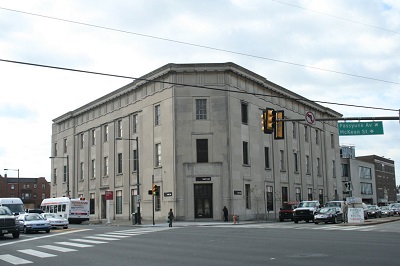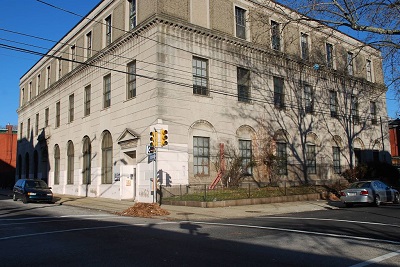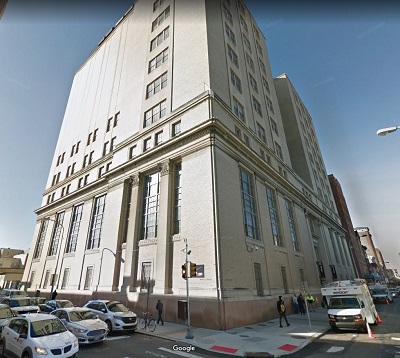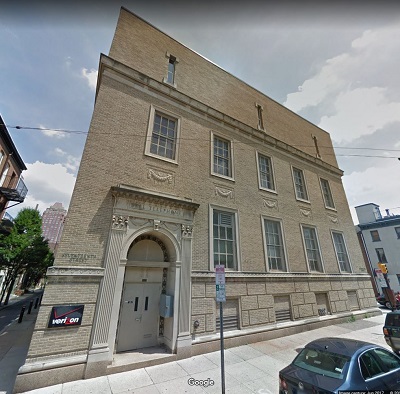Manhole Covers
Manhole covers are one point of entry into the city's underground world, and their designs indicate what part of that world they connect to. Here are some manhole covers that might help you identify pieces of the Internet.
PECO
PECO, formerly Philadelphia Electric Company, was formed in 1881 to construct and maintain infrastructure to supply electricity to Philadelphia and the surrounding suburbs. PECO owns 1,607 miles of high-voltage transmission lines, 15,250 square miles of underground distribution cable, and 12,933 miles of aerial distribution lines. It is currently owned by the Exelon Corporation, and merged with Commonwealth Edison's holding company Unicom Corp in 2000.
Keystone Telephone Company
Keystone Telephone Company began its existence in 1900 as a direct competitor to Bell Telephone Company. Keystone is often credited as the first phone system in the world with all wires installed via underground conduit. Primarily catering to businesses, Keystone also initially served municipal, fire, and police communications. Bell finally bought out Keystone in 1945, and subsequently retired the company's infrastructure due to redundancies. Keystone Telephone Company manhole covers are still in service, but the conduit is now owned by PECO, where one can assume it is used for electrical cabling.
Western Union Telegraph Company
Western Union began operation in 1851, quickly creating a vast telegraph network across the United States. By 1983, Western Union's international cable system properties were sold to MCI Communications (now owned by Verizon Communications). Western Union sent its last telegram in 2006, but it is unknown whether or not older telegraph lines were pulled out of operation before this time, or if domestic telegraph infrastructure was included in the deal with MCI Communications. The hexagonal pattern on these manholes was a standard for telecommunications at the time; it is often seen today on telephone company manholes.
Bell Telephone Company
Bell Telephone began as a company in 1879, and started operating Philadelphia within the same year. In 1984, the Bell system (then known as AT&T) was broken into seven "Baby Bell" companies, which led to Philadelphia being serviced by the new Bell Atlantic. In 2000, Bell Atlantic merged with the Connecticut-based GTE Corporation to form Verizon Communications, which still services the city of Philadelphia.
Metromedia Fiber Network
Originally launched in 1993 as National Fiber Network, Metromedia focused on running dark fiber to communications carriers in the U.S. and Europe. The company filed for bankruptcy in 2002, though it re-emerged in 2003 under the name Abovenet. In 2007, the company acquired fiver from AT&T and Verizon that was being sold to comply with antitrust law. The infrastructure is currently owned by the Zayo Group.
Electrical Bureau
The Electrical Bureau was a city department starting in 1856 to maintain signaling and communication systems of the police and fire bureaus. This included telegraph and telephone traffic between departments and their buildings. The Electrical Bureau was abolished in 1951, though its responsibilities are now transferred to the Communications group within the Department of Public Property.
MCI Metro
MCI Metro was a division of MCI Communications responsible for laying fiber-optic cable in the '90s. MCI, founded as Microwave Communications Inc. in 1963, was eventually bought by Worldcom in 1998, forming MCI Worldcom (and later just Worldcom in 2000). In 2003, Worldcom filed for bankruptcy and its assets were later acquired by Verizon Communications in 2006.
Level 3 Communications
Level 3 Communications began trading on NASDAQ in 1998, and began building a fiber network around the country. They are a major Tier 1 network, which means that their network has a direct connection to every other network online without paying fees to do so. In 2012, Level 3 received a $411 million contract from the Department of Defense's Defense Information Systems Agency (DISA) to provide fiber cable and maintenance support to DoD networks. This is just something that is interesting to know. They were purchased by CenturyLink in 2017.
Communications
This is a generic communications manhole, normally found near large business and college campuses. It may be used by different communications companies operating in the area.
Telephone
This peculiar "TELEPHONE" manhole cover is likely a replacement for a damaged Bell Telephone Company manhole cover.
Philadelphia Transportation Company
The Philadelphia Trasportation Company was the main public transportation operator in Philadelphia from 1940 to 1968 when it was replaced by SEPTA. The PTC was the successor to the Philadelphia Rapid Transit Company (PRT) founded in 1902. This manhole and others like it above trolley lines have been seen with red markings, implying that they are used to service power lines for transit.
High Pressure Fire System
The HPFS, considered to first debut in Philadelphia, was a high pressure fire system servicing red hydrants throughout the city, starting in 1903. The 56 mile system was praised for greatly reducing the number of fires in the city, and could shoot a two-inch stream 230 feet vertically. The system eventually fell into disrepair following improvements in fire engines and sprinkler systems, leading to decommission in 2005.
While you may see several red hydrants around the city, the HPFS hydrants are much wider and feature two independent gates (as opposed to the usual one). There is a color code associated with fire hydrant bonnets (tops) within the city (aside from fully red HPFS hydrants): Red for hydrants with 16" or larger mains, green for hydrants with mains between 10" and 16", and orange for hydrants with mains 8" or smaller.
CATV Handhole
Handholes are structures set below ground that protect telecommunications cables, providing convenient access for splicing or pulling cable. You have probably walked by lots of pull boxes before and not really know what they do.
This handhole is likely used by a provider to deliver cable television services to a a building. While cable television came to Philadelphia in 1983 under three franchises: Comcast, Cablevisions Systems of Philadelphia, and Philadelphia Inner City Cable (with a fourth, Wade Cablevision coming in 1987), Comcast now controls all cable within the city.
Traffic Handhole
Traffic systems handholes are often seen on the sidewalk corners near crosswalks. Cabling in these connects traffic lights to large green, metal control boxes that are usually situated nearby.
Verizon Handhole
Verizon handholes are often seen on the sidewalk corners, and are likely used for residential or commercial fiber lines.
Zayo Handhole
Zayo handholes have been popping up in Center City as of 2019. Zayo, founded in 2007, is a fiber network and Tier 1 operator with 130,000 route miles of fiber layed in North America. These handholes likely provide access for commercial fiber lines.
BellSouth
BellSouth is a telecommunications holding company that was created after the U.S. Department of Justice broke up AT&T on January, 1st 1984. The company operates exclusively in the American Southeast, which makes the presence of this manhole cover near 2nd & Market St in Philadelphia quite peculiar. It appears that the "Bell South" logo may have been etched or scratched into the surface of the manhole cover by hand. Note also that "Bell South" is not the canonical spelling of BellSouth, which is sometimes stylized as BELLSOUTH, but never includes a space. Further investigation is needed.
Street Markings
Sometimes you'll see a manhole cover that is surrounded with colorful markings. Whenever a contractor or construction company plans to do street excavation, utility companies will mark out the location of their underground cables so that the contractor knows to watch out for them.
There's a federal color-code standard for sidewalk markings. Philadelphia follows that standard.
Orange refers to the broad catch-all of "Communications, alarm, signal lines, cables and conduit." This means that orange lines can be internet cables, television cables, telephone lines, or other kinds of conduits.
The markings are sometimes really sloppy, and often in fragments. Sometimes you'll see several different labels in the same place. A lot of these cables are bundled up together running through ducts under the city.
PECO maintains a handy diagram for markings within Pennsylvania.
PECO
Here is a great marking for PECO in red (the standard color for electrical runs). Notice the capital "I" symbol next do it denoting the width of the conduit containing the cables. For more info on PECO, check out the manhole entry.
MCI
The telecommunications company currently owned by Verizon. For more information about MCI, check out the manhole entry for MCI Metro.
ATT
AT&T has been a presence in Philadelphia since the Bell System came to town in 1879. While local telephone operations have been under the control of Verizon for some time, markings are often done using the companies listed on planning documents, which can be outdated. Though AT&T doesn't have as strong of a presence within the city anymore, they still maintain a Central Office building at 500 South 27th St.
Verizon
Verizon markings using the letters "VZ" are becoming more common in the city to note conduit owned by Verizon.
Zayo
Zayo markings have been popping up in Center City as of 2019. Zayo, founded in 2007, is a fiber network and Tier 1 operator with 130,000 route miles of fiber layed in North America.
Crown Castle
Markings for "CCI" are likely attributed to Crown Castle, a communications infrastructure company. Crown Castle are known to run fiber supporting small cells
Survey Marker
How do you define "here", when "here" is subject to alteration by construction, or physical change over time? The National Geodetic Survey, a US Federal agency, maintains a network of graphic markers across the United States, including Philadelphia.
These markers can be explored on the National Geodetic Survey Data Explore website at https://www.ngs.noaa.gov/NGSDataExplorer/
Sometimes taking the the form of a metal disk implanted in a sidewalk or road, or a physical building, each marker in the NGS Network is marked by a data sheet as described here
These data sheets describe how to find the markers, the form the markers take, and location notes from recent surveyors on the condition of the markers. While some markers are on sidewalks publicly accessible, others can be in difficult to reach places such as a top City Hall on the William Penn statue. Though locations are chosen for perceived physical permanence, markers can go missing over time due to construction, theft, or vandalism.
Image via ngs.noaa.gov
Various Antennas
Tracking things on the ground can sometimes be tricky--markings and manhole covers get worn down and faded, they're sometimes in the middle of the road, and it's easy to bump into things when looking down all the time. Here are some other objects that indicate pieces of the network.
Distributed Antenna Systems
A Distributed Antenna System (DAS) is basically a way to expand a cell network's reach, adding capacity in under-covered areas. This blurry picture shows two units, both manufactured by JMA Wireless. One unit was also labeled "TEKO", a specific product line by JMA.
Small Cell
A small cell is a low-powered cellular radio access nodes that operate in licensed and unlicensed spectrum. Generally, small cells have a range of 10 meters to a few kilometers and are used to add coverage to an existing cellular network.
Air Quality Monitors
Air quality monitoring devices like this one at 18th and Vine started to appear in Philadelphia in early 2020. At the time of this posting, 50 of these devices have been installed within the city. Some units show markings for NYC, possibly indicating that these were used within New York or are surplus.
Image via u/peetauvw
Kiosks
Some weird boxy-things on the street might let you interact with them. Kiosks generally have screens, buttons, or speakers to convey information to you or behave in a transactional fashion.
LinkPHL
Pronounced "Link Philly," these 9.5-foot obelisks provide free WiFI access, mobile device charging, phone calls, access to municipal and emergency services, maps and directions, and information for community events. They are created by the company Intersection (previously Titan), with investment from Google parent Alphabet. Each LinkPHL kiosk has three cameras, and microphones, among other sensors.
Cameras
Admittedly, much of this guide has focused on seeing Internet-connected networks in the field--networks that, for the most part, the reader has access to. But the city is also full of networked objects that, while often serving a public interest, aren't connected to public networks. These sensors vary from monitoring vehicular traffic to recording water usage. Surveillance cameras are perhaps one of the more noticeable--and contested--forms of networked objects in public space. The public "connects" to surveillance networks all the time, albeit involuntarily, and this section offers a view into who controls some of the ubiquitous networks.
Police Cameras
The Philadelphia Police Department has a few surveillance cameras like this one at 15th and Latona. Thought to deter drug activity and other crime, these cameras have been in place since at least 2009 and automatically follow detected movement. It is unknown if anyone is currently monitoring this footage, or if these cameras are functional.
Image via u/finalstation
Sightseeing
There are few well-known locations that people tend to go to when they want to "see the Internet" in Philadelphia. Identifying these buildings when looking on the street is not always easy, but one telltale sign is to look for signs of ventilation and cooling systems. Alternatively, look for windows, or more accurately, the absence of them. (Note: on much larger buildings, in particular skyscrapers, vents also could just be a sign of a mechanical floor, the centralized space dedicated to maintaining utility needs for the entire building.)
New infrastructures have a tendency to inherit the homes of past infrastructures, and the Internet is no exception. Many of the major Internet exchanges and data centers of Philadelphia are in buildings that used to be telegraph switches, telephone company headquarters, and other industrial spaces. While this is by no means an exhaustive list, these are a few interesting starting points from which you can start looking for cable markings, cameras, or other signs of Internet infrastructure.
401 N Broad
Also known as the Terminal Commerce Building, this 14-story concrete building was built between 1929 and 1931 by the Reading Company (of railroad fame). Built to be an office park, showroom, and warehouse, the indestructible Art Deco building is now the largest telecommunications carrier hotel within Philadelphia with over 80 carriers as of 2015.
Image via wikipedia.org
500 South 27th
500 S 27th St (right by the South Street bridge) is an AT&T building presumably used for continued AT&T long distance service and collocation for other telephone companies. The building was comissioned in 1967 by Bell Telephone to replace an older exchange at 17th and the Parkway. Typical with telephone infrastructure, this building sites right next to railroad lines along the eastern side of the Schuylkill.
Image via philly.com
Three Logan Square
Formerly the Bell Atlantic Tower, this 55-story office building was erected in 1991 in Center City. After Bell split up, the Philadelphia-based Baby Bell Bell Atlantic headquartered within the building until 1996 when it purchased New York City-based NYNEX and moved operations to New York. Today the building is occupied by several tenants including Comcast and Bell Atlantic descendant Verizon.
The design of the building resembles a RJ-11 telephone jack.
Image via wikipedia.org
Bell Telephone Company Building
Built in 1925, 1835 Arch was an important long-distance telephone exchanged located centrally within Philadelphia. Long-lines service was discontinued at this site in the '70s when it was converted to office space, and continued to service Bell through 1990. It was since converted to apartments in 2001.
Image via wikipedia.org
Comcast Center
The Comcast Center at 1701 JFK was built between 2005 and 2008 to be the headquarters for Comcast after needing the need to occupy more space forced them to leave Centre Square. The 58-story building is the second tallest within Philadelphia behind the new 60-story Comcast Technology Center at 1800 Arch St.
Image via wikipedia.org
8 & 9 Preston
These two buildings at 8 and 9 Preston Street are former Bell Telephone and Keystone Telephone exchanges respectively. The Bell Telephone Exchange Building, also known as the Preston Telephone Exchange, was built in 1900. Competition was so fierce between the two companies they would often construct exchanges very close to one another. These two are both still standing over 50 years later.
1111 Locust
Completed in 1923, the Western Union Telegraph Company Building sits at 1111 Locust St. in Center City. Originally containing 70,320 square feet of office space for Western Union Telegraph Company, this building has been doubled in height due to modern retrofitting for re-use as apartment buildings. Throughout it's history this building changed with the times seeing usage as a telegraph hub hosting large telephone rooms, a Microwave Network Terminal site for Western Union's Microwave Relay sites, until ultimately falling out of use and being sold.
Image via Tom Woodall @ hiddencityphila.org
2401 Locust
2401 Locust is a carrier hotel located near Fitler Square. Dubbed "Philadelphia's Original Carrier Hotel," 2401 Locust boasts Level 3 and Quonix as residents.
Image via carrierhotels.net
1631 Arch
Originally known as the Bell Telephone Building, this central office (nicknamed "Locust") is currently owned and operated by Verizon to service Philadelphia.
Image via co-buildings.com
2000 S Broad
This central office (nicknamed "Dewey") is currently owned and operated by Verizon to service Philadelphia.
Image via co-buildings.com
1601 W Jefferson
This central office (nicknamed "Poplar") is currently owned and operated by Verizon to service Philadelphia.
Image via co-buildings.com
900 N Race
This central office (nicknamed "Market") is currently owned and operated by Verizon to service Philadelphia.
423 S 17th
This central office (nicknamed "Pennypacker") is currently owned and operated by Verizon to service Philadelphia.
3810 Chestnut
This central office (nicknamed "Evergreen") is currently owned and operated by Verizon to service Philadelphia.
8318 Germantown
This central office (nicknamed "Chestnut Hill") is currently owned and operated by Verizon to service Philadelphia.
4908 N Broad
This central office (nicknamed "Davenport") is currently owned and operated by Verizon to service Philadelphia.
3400 Island
This central office (nicknamed "Eastwick") is currently owned and operated by Verizon to service Philadelphia.
2514 Emerald
This central office (nicknamed "Regent") is currently owned and operated by Verizon to service Philadelphia.
5400 Woodland
This central office (nicknamed "Saratoga") is currently owned and operated by Verizon to service Philadelphia.
5650 Chestnut
This central office (nicknamed "Sherwood") is currently owned and operated by Verizon to service Philadelphia.
5160 Lancaster
This central office (nicknamed "Trinity") is currently owned and operated by Verizon to service Philadelphia.
6468 N Broad
This central office (nicknamed "Waverly") is currently owned and operated by Verizon to service Philadelphia.
3429 N 17th St
This central office (nicknamed "Baldwin") is currently owned and operated by Verizon to service Philadelphia.
26 W Chelten Ave
This central office (nicknamed "Germantown") is currently owned and operated by Verizon to service Philadelphia.
4332 Terrace St
This central office (nicknamed "Ivyridge") is currently owned and operated by Verizon to service Philadelphia.
4808 Leiper St
This central office (nicknamed "Jefferson") is currently owned and operated by Verizon to service Philadelphia.
7180 Charles St
This central office (nicknamed "Mayfair") is currently owned and operated by Verizon to service Philadelphia.
2210 Lott Ave
This central office (nicknamed "Orchard") is currently owned and operated by Verizon to service Philadelphia.
